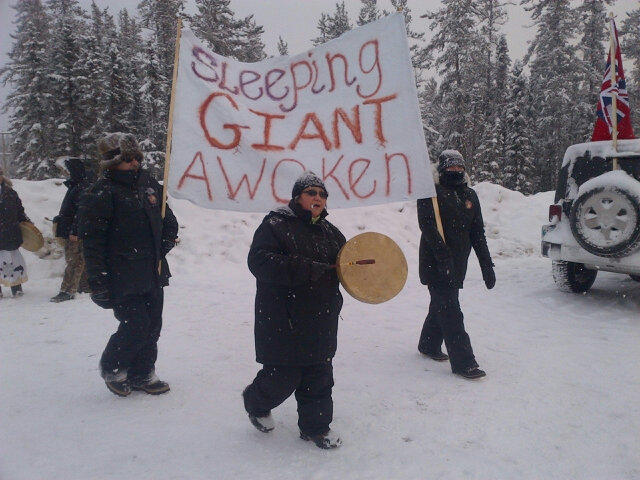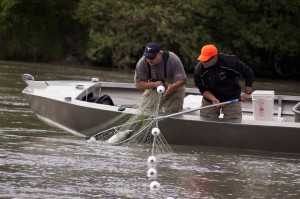
John Ahni Schertow, Intercontinental Cry
With the constant barrage of news headlines we’re confronted with, it can be very difficult to get a good fix on what exactly is going on these days, especially if you don’t know where to look. Most news providers are only interested in the latest trends (and, of course, whatever’s going to pay the bills). They ignore everything else.
In light of that fact, we wanted to put together a short briefing of important indigenous struggles that are taking place right now in Canada and the United States.
Note: If you know of something that isn’t on this list, please feel free to mention it in the comments below. All additional struggles will be added to the end of this briefing.
Last Updated: March 15, 2013
Mi’kmaq
Citizens from two different Mi’kmaq communities recently carried out an 11-day hunger strike to oppose the Made in Nova Scotia Process and the Made in New Brunswick Process, two framework agreements that follow a nationwide template in Canada that aims to extinguish Aboriginal sovereignty and title. Ultimately, the chiefs taking part in the process did not opt entirely, however, they did agree to halt negotiations until their communities can become better educated as to exactly what is at stake. The Mi’kmaq of Unamaki, meanwhile, are still attempting to deal with a proposed shale gas fracking development project at Lake Ainslie, the largest freshwater lake in Cape Breton.
Pit River Tribe
The Pit River Tribe Of California unanimously affirmed their opposition to geothermal and other industrial developments in the sacred Medicine Lake Highlands, located in Northeastern California . In a recent public statement, the tribe explained that “Geothermal development in such a sensitive hallowed place will despoil the environment and harm the Pit River Tribe.” Pit River has been struggling against geothermal development in the region since the 1980s, when the Bureau of Land Management (BLM) sold geothermal development leases to three corporations without consulting anyone.
Red Lake Anishinaabe
The Red Lake Anishinaabe Nation recently stood up to Enbridge Energy LP, a company that is openly trespassing on Red Lake Ceded lands in Minnesota, operating multiple pipelines without an easement. Through their ongoing protest camp, Nizhawendaamin Indaakiminaan, a group of grassroots Red Lake tribal members and allies, are demanding that the flow of oil through these pipelines be stopped.’
Havasupai
The Havasupai Nation joined forces with three conservation groups to sue the U.S. Forest Service over its decision to allow Energy Fuels Resources, Inc. to begin operating a uranium mine near Grand Canyon National Park without initiating or completing formal tribal consultations and without updating an outdated 1986 federal environmental review. As stated in a recent joint press release, “The Canyon Mine threatens cultural values, wildlife and endangered species and increases the risk of soil pollution and pollution and depletion of groundwater feeding springs and wells in and near Grand Canyon.” For more on the active threat of uranium mining at the Grand Canyon, please see here.
Mathias Colomb Cree Nation
The Mathias Colomb Cree Nation (MCCN) and The Wilderness Committee are working to oppose Hudson Bay Mining and Smelting Company’s (Hudbay) new Reed Mine project in Grass River Provincial Park. Pointing to unaddressed environmental concerns and a lack of free, prior and informed consent, MCCN Chief Arlen Dumas recently explained, , “The Reed Lake mine proposed by Hudbay is within the unceded traditional territories of Mathias Colomb Cree Nation. This proposed mine raises serious concerns in relation to caribou populations, water quality, and carbon emissions. The province of Manitoba and the proponent, Hudbay, have failed to meet with MCCN, the true owners of these lands and resources, in good faith to obtain our free, informed and prior consent on any proposed activities within our territories.”
Muscogee-Creek
Hickory Ground Tribal Town member, Wayland Gray, Muscogee-Creek, was recently arrested and charged with making a terrorist threat for peacefully entering the construction site of the expansion of the Wind Creek Wetumpka Casino. Wayland, who was arrested with three others, entered the site to pray over the desecration of the grounds because it is where 57 ancestral remains were unceremoniously moved to make room for the casino expansion. Wayland has since been released form jail, however, the charge of uttering a terrorist threat remains. Watch a video of the arrest.
Innu
In Quebec, the Innu are continuing to reject the “North for all” plan, a massive economic, social, and environmental development project that will directly impact Innu tradition, culture, language and history. The Plan Nord is a multi-faceted resource-exploitation project that involves digging mines, expanding forestry, and damming a slew of rivers.
Lummi
The Lummi Nation is continuing to push against the proposed Gateway Pacific coal terminal at Xwe’chi’eXen (Cherry Point), a sacred landscape the Lummi have relied on for over 3,500 years. The proposed terminal and shipping point would be used to export Powder River Basin coal to China. If built, the project will set the stage for the possible destruction of all live in the Salish Sea. As Jay Julius, member of Lummi Nation tribal council recently pointed out, it could also destroy underwater archaeological sites and upland burial grounds. Late last year, a wid spectrum of Native and non-Native Fishers joined the Lummi Nation to oppose the project.
Wolf Lake and Eagle Village
While not a struggle per se, there is a situation with a proposed ‘rare earth’ mine that we should keep an eye on, for obvious reasons. In western Ontario, Wolf Lake and Eagle Village First Nation have entered into a Memorandum of Understanding (MOU) with Matamec Explorations Inc., over a proposed yttrium-zirconium mine. Rare earth mines have gained alot of attention over the past couple years for the notorious amount of pollution they produce. The two First Nations are undoubtedly aware of this, however, they have decided to take a facts-based approach concerning Algonquin cultural impacts social economic impacts and specific environmental impacts.
Lake St. Martin First Nation
The entire population of the Lake St. Martin First Nation continues to remain homeless after their reserve was drowned in water by the Manitoba government in 2011. As if the loss of their homes was not enough, the people of Lake St. Martin were left with no choice but to relocate to an old military base that has no infrastructure. For more on this, be sure to look at: Flooding Hope: Displacement Politics by the Province towards Lake St. Martin First Nation.
Dineh, Hopi and Zuni
A coalition of Indigenous and non-indigenous groups are working to stop the development of the Grand Canyon Escalade project at the confluence of the Colorado and Little Colorado Rivers on the Navajo Reservation in Arizona. The $120 million resort and tramway project is being pushed forward by the Navajo Nation government despite the obvious risks to the environment and the cultural and spiritual well-being of the Dineh, Hopi and Zuni Peoples. Several groups have come together to stop the project, including the Diné Medicine Man Association, Inc., Forgotten People, Next Indigenous Generation, and the Grand Canyon Trust. Hopi leaders have also unanimously agreed to oppose the commercial initiative.
Ohlone, Miwok and Yokut
The Ohlone, Miwok and Yokut peoples are working to protect Brushy Peak, a sacred place near Livermore, California, that is a part of their origin stories. The East Bay Regional Park District (EBRPD), which maintains and operates a system of regional parks within the San Francisco Bay Area, wants to turn the area into a recreational preserve against the wishes of the concerned Indigenous peoples. Buried Voices, a new documentary film by Michelle Steinberg, provides a great deal of insight into this ongoing struggle. Other recent struggles in the region include the effort to protect Glen Cove (Sogorea Te) and Rattlesnake Island.
Navajo, Hopi, Apache, Acoma, Zuni…
The long-running struggle to defend the San Fransisco Peaks continues in Arizona, despite the fact that the infamous Snowbowl has since become the first ski area in the world to make fake snow from 100% treated sewage waste water. Activists working to defend the Peaks lament that “We have temporally lost this battle with attacks on us from the U.S. Forest Service and the so called U.S. ‘judicial system’”. Nevertheless, they remain committed to stopping the production and use of the disgusting snow.
Anishinaabe
A group of Anishinaabe citizens from seven different communities/reservations in northern Minnesota are struggling to defend the sacred manoomin (wild rice) from the dire impacts of sulfate contamination. the group, known as Protect Our Manoomin is working specifically to oppose mining legislation that endangers manoomin and the ecosystem of northern Minnesota; and to educate and inform Anishinaabe communities of the imperilment of nonferrous mining. Companies that are currently threatening manoomin include PolyMet/Glencore, Twin Metals/Antofagasta, and Kennecott/Rio Tinto.
Ktunaxa
The Ktunaxa, meanwhile, are continuing to resist an impending cultural and environmental disaster in southeastern British Columbia. The Jumbo Glacier resort proposal, located in the heart of Qat’muk (GOT-MOOK), threatens critical grizzly bear habitat, and ignores the cultural and spiritual significance of the area to the Ktunaxa. According to Ktunaxa belief, Qat’muk is home to the Grizzly Bear Spirit, which makes it a culturally pivotal sacred site. The BC government, in order to move forward with the project, recently created the Jumbo Glacier Resort Municipality (JGRM), a municipal body that doesn’t represent any actual people. The undemocratic body is being challenged in court.
Asubpeeschoseewagong
Grassy Narrows is gearing up for yet another court battle in their decade-long struggle against clearcut logging on their territory. In January, the Ontario Government began proceedings to overturn a major legal victory that was eleven years in the making. On August 16, 2011, Ontario Superior Court Justice Saunderson found that the Government of Ontario did not have the power to unilaterally take away rights outlined in Treaty 3. The province preposterously claims that Justice Saunderson’s analysis was the “antithesis of reconciliation.” Grassy Narrows meanwhile, continues to cope with the impacts of mercury pollution on their lands along with White Dog FN and some members of Wabauskang who lived at Quibell. In March 1962 Dryden Chemicals began dumping an estimated 10 metric tonnes of mercury into the Wabigoon River, contaminating the fish which formed the subsistence and economy of all three communities. The mercury was never cleaned up.
Dineh
Returning to Navajo territory, uranium companies are working double time to convince the Navajo nation to let them mine their “uranium-rich” land, despite the overwhelming number of abandon uranium mines that continue to pollute the territory. There are over 1000 abandon mines.
The Confederated Tribes of the Goshute
Elsewhere in the Southwest, the Confederated Tribes of the Goshute are stepping forward to stop a water pipeline that has been proposed by the Southern Nevada Water Authority (SNWA). According to the Protect Goshute Water website, the pipeline “would draw 150,000 acre feet per year from the Great Salt Lake Watershed Basin lowering the water table, drying up our springs, and fundamentally changing access to water over this vast region for plants, wildlife, and people.. Even a slight reduction in the water table will result in a cascade of wildlife and vegetation impacts directly harming our ability to engage in traditional practices of hunting, gathering, and fishing on ancestral lands.”
Cree
The Grand Council of the Crees just called on the Quebec government to move forward with its plan to convene an independent evaluation of the uranium industry in Quebec. The Cree Nation of Eeyou Istchee has consistently stated its opposition to uranium mining in all its forms in the Eeyou Istchee James Bay territory. In August 2012, the Cree Nation enacted a permanent moratorium on uranium exploration, mining, milling and waste emplacement in Eeyou Istchee. The Crees are also intervening in the legal proceedings recently commenced against Environment Quebec by Strateco Resources, the proponent of the Matoush advanced uranium exploration project, the most advanced uranium project proposed to date in the Province.
Dene
The Yellowknives Dene First Nation (YKDFN) and Lutsel K’e Dene First Nation (LKDFN) announced in February that they will not support the proposed Nechalacho rare earth mine at Thor Lake, about a 100 km southeast of Yellowknife. The project would exploit a total 15 rare earth metals – including radioactive ones like uranium and thorium. The YKDFN explained their opposition stems from a deteriorating relationship with the company behind the project and that the potential environmental impacts resulting from the project far exceed the perceived benefits.
Winnemem
The Winnemem Wintu Tribe and their allies are pushing against the proposed Shasta Dam expansion project, which would flood the Winnemem’s sacred sites for a second time! The proposed expansion also jeorpardizes the site of the Winnemem Coming of Age ceremony. Furthermore, in conjunction with the Bay Delta Conservation Plan it would also hasten the extinction of Central Valley salmon, steelhead, Delta smelt, longfin smelt, green sturgeon and other fish species.
Alutiiq, Cherokee, Chumash, Crow, Dakota, Euchee, Lakota, Mohawk, Navajo, Ojibwe, Salish, Sauk, Squamish Wampanoag…
Amidst these many struggles, there are numerous efforts around the continent dedicated to reclaiming, revitalizing, and securing traditional languages, many of which are on the brink of extinction. In Canada alone, there are over 60 communities working to record/document their languages before they are lost. As highlighted at Our Mother Tongues, language revitalization efforts include the Akwesasne Freedom School, the Chumash “Silent No More” project at the University of California at Berkeley, the Wicoie Nandagikendan: Dakota-Ojibwe Language Immersion Preschools and the Wôpanâak Language Reclamation Project. Also, The Squamish Language is making a come back; and efforts are underway for language reclamation at Shoal Lake. Then there is the Digital Indigenous Democracy project, described by Christa Couture of RPM.fm as “a remarkable endeavor that will bring interactive digital media to eight remote Baffin Island Inuit communities – communities whose 4,000 year-old oral language will become extinct without digital media to carry it forward into the next generation.” There are many other programs and efforts across the US and Canada; new ones are appearing all the time.
Attawapiskat First Nation
In recent months, the Cree community of Attawapiskat has held a constant presence in the news. Most notably, Attawapiskat Chief Theresa Spence carried out a six week fast as a part of IdleNoMore; and let’s not forget the coordinated media effort to discredit her in order to weaken the IdleNoMore movement. Last month, members of Attawapiskat also set up a blockade on the road leading to the De Beers Victor mine with a second blockade by a different group of Attawapiskat citizens who wanted their own concerns addressed. Meanwhile, the reserve continues to cope with a long-standing housing shortage.
Wet’suwet’en
For more than 15 months, the Grassroots Wet’suwet’en peoples have maintained The Unist’ot’en Camp, a resistance community that was established to protect Wet’suwet’en territory from several proposed pipelines from the Tar Sands Gigaproject and shale gas from Hydraulic Fracturing Projects in the Peace River Region. Most recently, in November, the Wet’suwet’en of the C’ilhts’ekhyu and Likhts’amisyu Clans confronted, and escorted out, employees and drillers of the Pacific Trails Pipeline (PTP) who were attempting to enter Wet’suwet’en lands without consent.
Aamjiwnaang
Aamjiwnaang is an Anishinaabe reserve located just outside of the city of Sarnia in Southwestern Ontario–an read well known as “Chemical Valley.” Home to 40% of Canada’s petrochemical industry, the Chemical Valley region experiences some of the worst air pollution in Canada. The Aamjiwnaang Reserve, boxed in by industry on three sides, bears the brunt of this pollution. Currently, two Aamjiwnaang band members, Ron Plain and Ada Lockridge, are confronting this with a lawsuit against the Ontario Ministry of Environment (MOE) and Suncor Corporation. Their argument is a simple one: they believe it is a basic human right to step outside one’s home and not breathe air harmful to one’s health. Another challenge faced by the community is the lack of legal protection from spills and intentional dumping of toxic chemicals within the reserve, a problem that is known very well by reserves across the country.
Blackfeet
For the past few years, the Blackfeet Nation in what is now northern Montana have been struggling with a problem that has now reached several reserves across the continent: the controversial practice known as fracking. In the case of the Blackfeet, who are one of three members of the Blackfoot Confederacy, fracking has not only harmed the land. It has also divided the Blackfeet People. Since 2009, the Blackfeet Nation Tribal Council has taken it upon itself to lease out 1 million acres or 66% of the reservation to three companies: Newfield, Anschutz Exploration, and Rosetta Resources. Blackfeet citizens have had little say in the actions of the Tribal Council, nor opportunities to learn about what is being done on their land. Fortunately, there are those among the Nation who are demanding accountability, transparency, and who wish to defend their land from the pollution of oil and fracking chemicals.
Kanai (Blood Tribe)
The Kanai, another member of the Blackfoot Confederacy, find themselves in much the same situation as their southern relatives, the Blackfeet. In this case, the Kanai Tribal and Business Councils signed almost half of the reserve over to oil companies, again, without any involvement from the citizenry. The situation gained major headlines in 2011 when three Kainai women carried out a protest on the Blood Reserve, in southern Alberta. Soon after the protest began, all three women were arrested and charged with trespassing and intimidation. Sadly, there have been no other major protests since then.
Athabasca Chipewyan
In northern Alberta, the Athabasca Chipewyan First Nation (ACFN) is trying to stop an oilsands expansion project on their traditional territory. Industrialization of the Denesuline community’s traditional territory has lead to the cumulative removal of lands, wildlife and fish habitat as well as the destruction of ecological, aesthetic and sensory systems. The expansion of Shell’s Jackpine Project would cause even more damage, specifically at Poplar Point, the heart of the ACFN homelands.
Barriere Lake Algonquins
For more than twenty years, the Algonquins of Barriere Lake have been struggling to get the governments of Canada and the Province of Quebec to honour the landmark 1991 Trilateral Agreement, an alternative to Canada’s preferred negotiation policy, called the “Comprehensive Land Claims.” Canada has tried every trick in the book in order to get out of the 1991 agreement, including placing the community under third party management using Section 74 of the Indian Act. The community has won some important victories over the last couple years – and one or two that were less than ideal – nevertheless, ABL presses on. Most recently, the Algonquins made there position clear on proposed exploration activities of the junior mining company Copper One.











